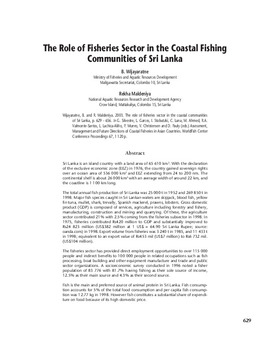The role of fisheries sector in the coastal fishing communities of Sri Lanka

Citation
Wijayaratne, B.; Maldeniya, R. (2003). The role of fisheries sector in the coastal fishing communities of Sri Lanka. p. 629-656. Assessment, management and future directions for coastal fisheries in Asian countries. WorldFish Center conference proceedings; 67
Sri Lanka is an island country with a land area of 65 610 km2. With the declaration of the exclusive economic zone (EEZ) in 1976, the country gained sovereign rights over an ocean area of 536 000 km2 and EEZ extending from 24 to 200 nm. The continental shelf is about 26 000 km2 with an average width of around 22 km, and the coastline is 1 100 km long. The total annual fish production of Sri Lanka was 25 000 t in 1952 and 269 850 t in 1998. Major fish species caught in Sri Lankan waters are skipjack, blood fish, yellow fin tuna, mullet, shark, trevally, Spanish mackerel, prawns, lobsters. Gross domestic product (GDP) is composed of services, agriculture including forestry and fishery, manufacturing, construction and mining and quarrying. Of these, the agriculture sector contributed 21% with 2.5% coming from the fisheries subsector in 1998. In 1975, fisheries contributed Rs420 million to GDP and substantially improved to Rs24 823 million (US$382 million at 1 US$ = 64.90 Sri Lanka Rupee; source: oanda.com) in 1998. Export volume from fisheries was 3 240 t in 1985, and 11 433 t in 1998; equivalent to an export value of Rs453 mil (US$7 million) to Rs6 732 mil. (US$104 million). The fisheries sector has provided direct employment opportunities to over 115 000 people and indirect benefits to 100 000 people in related occupations such as fish processing, boat building and other equipment manufacture and trade and public sector organizations. A socioeconomic survey conducted in 1996 noted a fisher population of 83 776 with 81.7% having fishing as their sole source of income, 12.5% as their main source and 4.3% as their second source. Fish is the main and preferred source of animal protein in Sri Lanka. Fish consumption accounts for 5% of the total food consumption and per capita fish consumption was 12.77 kg in 1998. However fish constitutes a substantial share of expenditure on food because of its high domestic price. The policy of almost all fisheries projects in Sri Lanka has been to maximize the fisheries resource utilization for direct extractive purposes rather than for sustainable resource management. This short-range orientation has increased the efficiency of fishing operations through the application of advanced technologies in fish capture, leading to a shift from the traditional fishing methods to the adoption of modern fishing gear. This has led to the depletion of fishery resources, particularly in the coastal waters. Thus there is a need to adopt programmes that emphasize the development of offshore fishing and thereby reduce fishing pressure in the coastal areas. Implementation of alternative livelihood opportunities would also improve the quality of life of coastal fishers.
Permalink
Date Available
Type
Publisher
Countries
Copyright
CC BY 4.0
Research Themes
Topics
Language